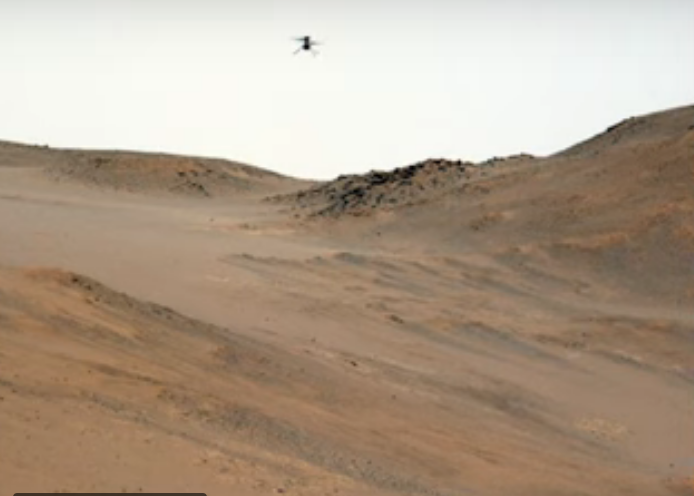
Features
Aircraft
Innovations
New Technologies
NASA uses two planets to test future Mars helicopter designs
November 23, 2023 By Helicopters Staff
 An image taken from video of the Ingenuity Mars Helicopter’s 54th flight, on Aug. 3, 2023, captured by NASA’s Perseverance Mars rover. Image Credit: NASA
An image taken from video of the Ingenuity Mars Helicopter’s 54th flight, on Aug. 3, 2023, captured by NASA’s Perseverance Mars rover. Image Credit: NASA For the first time in history, and courtesy of NASA, tests of future aircraft designs have been carried out on two different planets.
On Earth, a new rotor that could be used with next-generation Mars helicopters was recently tested at NASA’s Jet Propulsion Laboratory (JPL) in Southern California, spinning at near-supersonic speeds (0.95 Mach). And on Mars, meanwhile, the agency’s Ingenuity Mars Helicopter has achieved new altitude and airspeed records in the name of experimental flight testing.
“Our next-generation Mars helicopter testing has literally had the best of both worlds,” said Teddy Tzanetos, Ingenuity’s project manager and manager for the Mars Sample Recovery Helicopters. “Here on Earth, you have all the instrumentation and hands-on immediacy you could hope for while testing new aircraft components. On Mars, you have the real off-world conditions you could never truly re-create here on Earth.” That includes the very thin Mars atmosphere and significantly less gravity than on Earth.
The next-generation carbon fiber rotor blades being tested on Earth are almost 4 inches, or more than 10 centimeters, longer than Ingenuity’s, with greater strength and a different design. NASA believes these blades could enable bigger, more capable Mars helicopters. The challenge, NASA said, is that as the blade tips approach supersonic speeds, vibration-causing turbulence can quickly get out of hand.
To find a space big enough to create a Martian atmosphere on Earth, engineers looked to JPL’s 25-foot-wide, 85-foot-tall, or 8-meter-by-26-meter, space simulator, where for three weeks in September, a team monitored sensors, meters, and cameras as the blades endured run after run at ever-higher speeds and greater pitch angles.
At around the same time, and about 100 million miles away, Ingenuity was conducting a series of flights on the real Mars. It first flew on April 19, 2021, hovering at 10 feet, or 3 meters, for 30 seconds. Four more flights in as many weeks added 499 seconds and saw the helicopter flying horizontally over the surface for 1,171 feet, or 357 meters. Originally slated to fly no more than 5 times, the helicopter has exceeded its planned 30-day mission by 32 times and has flown 66 times to date – and every time Ingenuity goes airborne, NASA said, it covers new ground. “Over the past nine months, we have doubled our max airspeed and altitude, increased our rate of vertical and horizontal acceleration, and even learned to land slower,” said Travis Brown, Ingenuity’s chief engineer at JPL. “The envelope expansion provides invaluable data that can be used by mission designers for future Mars helicopters.”
Limited by available energy and motor-temperature considerations, Ingenuity flights usually last around two to three minutes. Although the helicopter can cover more ground in a single flight by flying faster, flying too fast can confuse the onboard navigation system, which uses a camera that recognizes rocks and other surface features as they move through its field of view. But since the system can lose its way if the features move by too quickly, the team sends commands for Ingenuity to fly at higher altitudes (instructions are sent to the helicopter before each flight), which keeps features in view longer. Flight 61 established a new altitude record of 78.7 feet, or 24 meters, as it checked out Martian wind patterns, NASA said, and Flight 62 set a speed record of 22.3 mph.
The team has also been experimenting with Ingenuity’s landing speed. The helicopter was designed to contact the surface at a relatively brisk 2.2 mph so that its onboard sensors could easily confirm touchdown and shut down the rotors before it could bounce back into the air. A helicopter that lands more slowly could be designed with lighter landing gear. So, on Flights 57, 58, and 59, Ingenuity was landed at speeds 25 per cent slower than it was originally designed to land at.
The Ingenuity Mars Helicopter was built by JPL, which also manages the project for NASA Headquarters. It is supported by NASA’s Science Mission Directorate. NASA’s Ames Research Center in California’s Silicon Valley and NASA’s Langley Research Center in Hampton, Virginia, provided significant flight performance analysis and technical assistance during Ingenuity’s development. AeroVironment Inc., Qualcomm, and SolAero also provided design assistance and major vehicle components. Lockheed Space designed and manufactured the Mars Helicopter Delivery System.